|
This is a sterno stove, something that has been sold in sporting goods store since at least the early 70's. It was considered
a backpacking stove, and back then men were men - not gram-weenies. It was designed to use a gelled alcohol fuel called
Sterno, which is still available today. Mostly used as chafing dish warmers nowdays. Last time I looked, the Sterno stoves
are plain aluminium colored (anodized finish) and sell for $8 at the local Joes. The one pictured here is about 30 years old,
at least.
The Sterno stove is designed to be a cook base for frying, boiling, etc. using large pans. It is very strong, so strong
that I would imagine you could stand on it. It has some clever hooks and cut out on the bottom to hold a can of Sterno fuel.
It just so happens that a 6oz tuna can also fits in the fuel holder. As seen later, a tuna can can be used as a base to hold
a Trangia burner. However, a Sterno fuel can is much taller than a tuna can.
| Standard Sterno Stove |
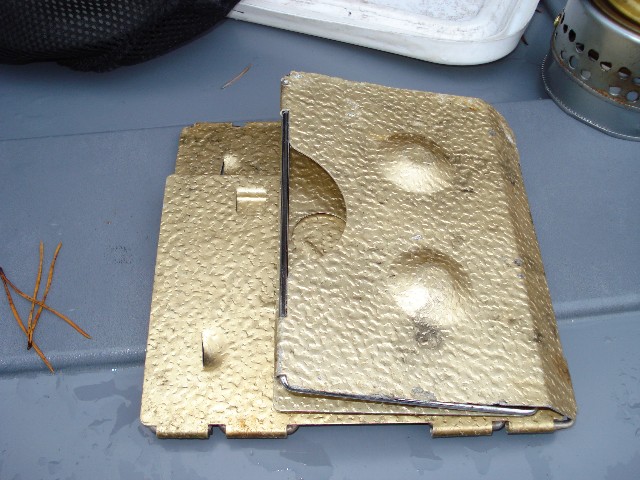
|
Here's the complete setup.
This is what I use for my tailgate cooking. "tailgate cooking" is what I do when I want a hot meal when out fishing,
hunting, etc.
You could use this for backpacking too. This is a combination windscreen, and pot stand. It is very strong. It is made
of aluminium and steel rod. Like the Trangia burner, it is very sturdy. Unlike gram-weenie pop can stove setups, you can cook
a real meal with this.
Note that I cut the two center support bars out. They seemed to do nothing except soak up heat and turn bright red. The
only downside is that I can't warm up a can of chilli.
| Stove, burner, burner stand |
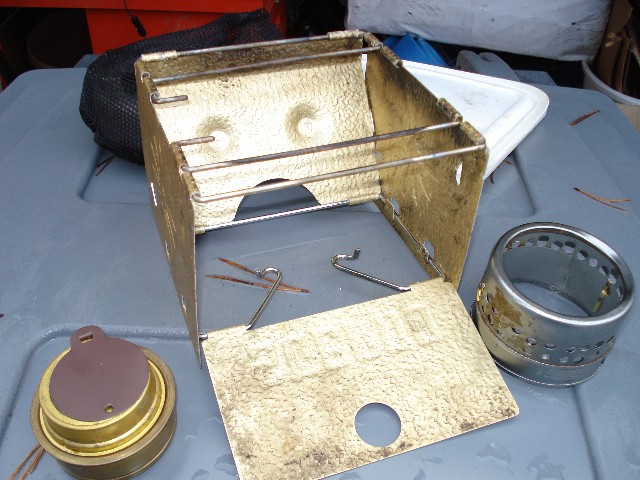
|
| Note the two center bars removed |
The key to using the Sterno stove with the Trangia burner ($13) is to create a burner stand (two tuna cans in this case)
to position and support the burner. The ideal burner to pot bottom distance for just boiling water is 1.75". But when frying
and simmering, I like the distance to be about 1", which is what I've accomplished with the two tuna cans as shown. A single
tuna can puts the distance at about 2". I never tried just using an empty sterno fuel can, which might be closer to the right
height.
| Two 6oz tuna cans joined with a paper brad |
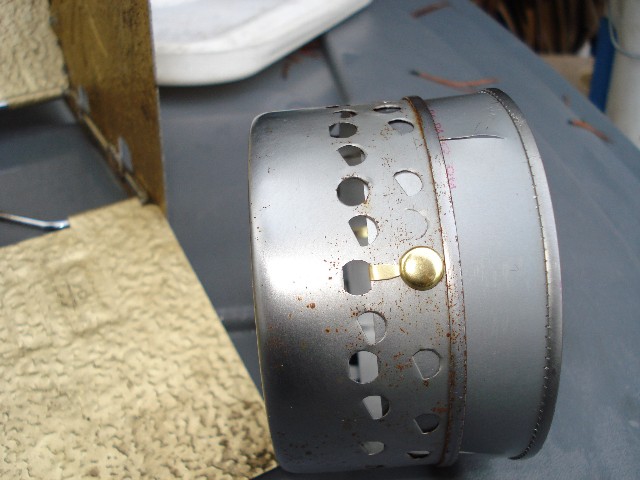
|
Here is the assembled stove. The burner is lit and running, but you can't see the flame. This is probably something
1st-time alky stove users have to get used to, i.e. you have to light, trust that it is lit, wave your hand over it quickly
to make sure and then get on with cooking. Until you trust that the Trangia won't blow out, you'll lose the hair on your knuckles.
| Ready to cook at full throttle |
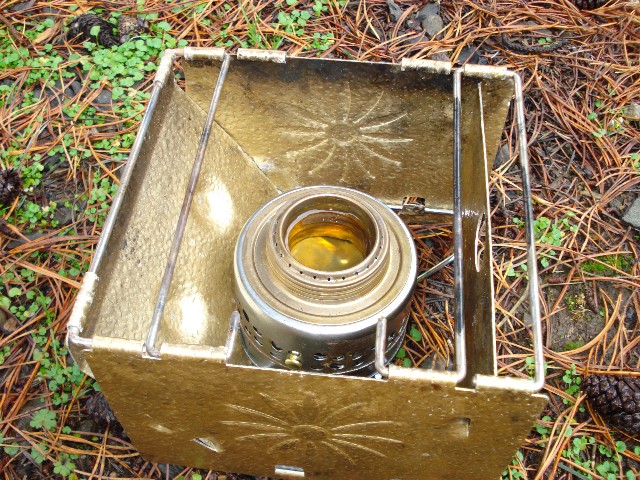
|
I'm going to cook a couple eggs in a 7" cheapo fry pan. A full-throttle Trangia is way too hot, so I'm going to use the
simmer ring. Somewhere between 50% to 70% seems about right for sunny-side up eggs. The temperature is 38* and there is a
slight breeze.
| Simmer ring in place for about 1/2 throttle |
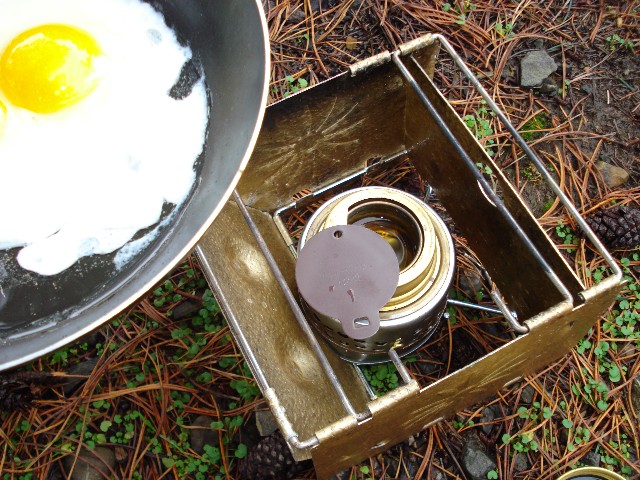
|
And this is how I like my eggs - sunny-side up. And this is something you can do with the Trangia that you can't
do with a gram-weenie pop can stove. Something to consider if you actually like to cook once in a while.
| Perfect eggs at 38*F, Alcohol stove |
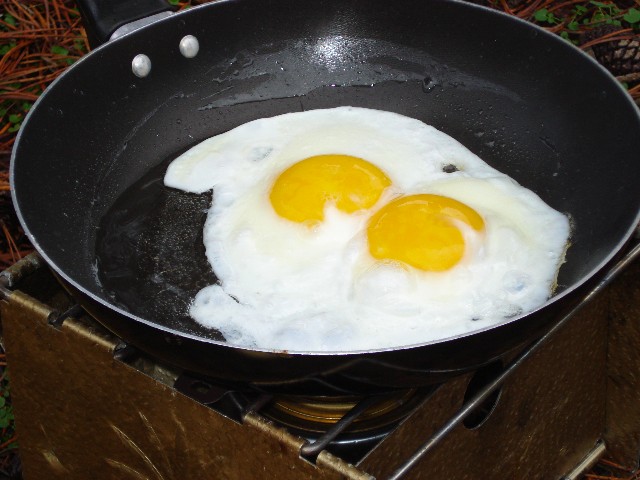
|
And just to show something else, something definitely not backpacking, the following is a 8qt pot with 1 gallon of water
boiling on the sterno/trangia combo. The outside temp was 39*F and it took 45 minutes to bring it to a roiling boil. The Trangia
was refilled once. This is definitely beyond what I would want to do with an itty-bitty alcohol burner, but it can be done.
I tried the same experiment again, but this time using the simmer ring fully open. The burner ran for 1.5 hrs on a single
fill, but never brought the 1 gallon of water to a boil (hit about 180*F). It was a bit colder and windier, but I could tell
that just adding the simmer ring cuts the burner output to about 50%, which is not enough BTUs to boil a gallon of water.
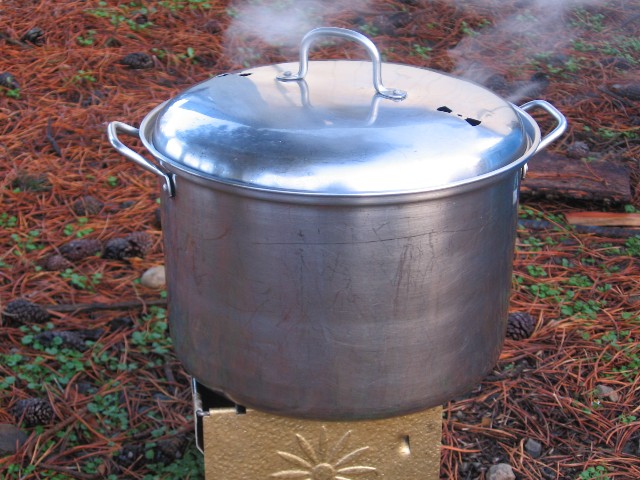
|